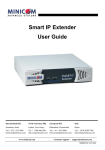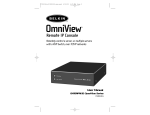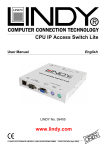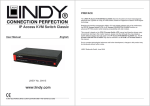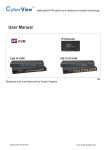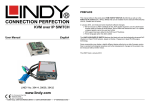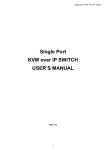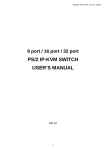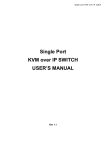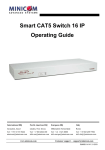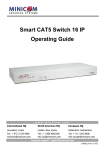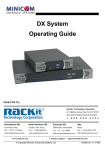Download Minicom Advanced Systems Smart IP Extender User guide
Transcript
Smart IP Link User Guide Supported by: ® Rackit ® Technology Corporation 274 Madison Avenue, New York, NY 10016 Tel: (212) 679-0050 • Fax: (212) 679-0040 Technology Corporation 1 . 8 0 0 . 6 3 6 . 3 4 3 4 International HQ North American HQ European HQ Italy Jerusalem, Israel Linden, New Jersey Zurich, Switzerland Rome Tel: + 972 2 535 9666 [email protected] Tel: + 41 1 455 6220 Tel: + 1 908 4862100 [email protected] [email protected] www.minicom.com Tel: + 39 06 8209 7902 [email protected] Customer support - [email protected] 5UM20115 V1 9/03 SMART IP LINK Welcome The Smart IP Link system is produced by Minicom Advanced Systems Limited. Technical precautions This equipment generates radio frequency energy and if not installed in accordance with the manufacturer’s instructions, may cause radio frequency interference. This equipment complies with Part 15, Subpart J of the FCC rules for a Class A computing device. This equipment also complies with the Class A limits for radio noise emission from digital apparatus set out in the Radio Interference Regulation of the Canadian Department of Communications. These above rules are designed to provide reasonable protection against such interference when operating the equipment in a commercial environment. If operation of this equipment in a residential area causes radio frequency interference, the user, and not Minicom Advanced Systems Limited, will be responsible. Changes or modifications made to this equipment not expressly approved by Minicom Advanced Systems Limited could void the user’s authority to operate the equipment. Minicom Advanced Systems Limited assumes no responsibility for any errors that appear in this document. Information in this document is subject to change without notice. No part of this document may be reproduced or transmitted in any form or by any means, electronic or mechanical, for any purpose, without the express written permission of Minicom Advanced Systems Limited. © 2003 Minicom Advanced Systems Limited. All rights reserved. Trademarks All trademarks and registered trademarks are the property of their respective owners. 1 USER GUIDE Table of Contents 1. 2. 3. 4. 5. 6. 7. 8. 9. 10. 11. 12. 13. 14. 15. 16. 17. 18. 19. 20. 21. 22. 23. 24. 25. 26. 27. 28. 29. 30. 31. 32. 33. 34. 35. 36. 37. 38. 39. 40. 41. 42. Introduction ................................................................................................................................... 4 Features of IP Link ........................................................................................................................ 4 Remote power management ........................................................................................................ 5 System components ..................................................................................................................... 5 The IP Link cables ......................................................................................................................... 5 IP Link front panel ......................................................................................................................... 6 The IP Link rear panel ports ......................................................................................................... 6 Pre-installation instructions ......................................................................................................... 7 Connecting the IP Link to the host computer/KVM switch ....................................................... 7 Connecting the Power management option ............................................................................... 9 Connecting to Ethernet................................................................................................................. 9 10 Mbps Connection ..................................................................................................................... 9 100 Mbps Connection ................................................................................................................. 10 Switching on ................................................................................................................................ 10 Configuring the system .............................................................................................................. 10 Configuring system via DHCP server........................................................................................ 10 Configuring system via local console....................................................................................... 11 IP Link Video Modes ................................................................................................................... 12 Operating the IP Link system..................................................................................................... 12 Logging in .................................................................................................................................... 13 Server Power Status ................................................................................................................... 14 Timeout......................................................................................................................................... 14 Remote Console .......................................................................................................................... 14 Keyboard layout .......................................................................................................................... 15 Toolbar buttons and icons ......................................................................................................... 15 The Video settings ...................................................................................................................... 16 Mouse synchronization .............................................................................................................. 17 Single mouse mode .................................................................................................................... 18 Synchronizing the client and host mice.................................................................................... 18 Remote Console Settings ........................................................................................................... 19 SSL settings................................................................................................................................. 19 Mouse Settings ............................................................................................................................ 21 Remote Console Type................................................................................................................. 21 Mouse hotkey .............................................................................................................................. 22 Remote Console Button Keys .................................................................................................... 22 Network Settings ......................................................................................................................... 23 Dynamic DNS ............................................................................................................................... 25 Serial Settings ............................................................................................................................. 26 User settings................................................................................................................................ 30 Maintenance................................................................................................................................. 31 Frequently Asked Questions...................................................................................................... 33 Glossary of terms ........................................................................................................................ 34 2 SMART IP LINK Appendix A: IP Link Video modes ........................................................................ 35 Appendix B: Key codes.......................................................................................... 36 Appendix C: Pin assignments ............................................................................... 38 Appendix D: Technical specifications .................................................................. 40 3 USER GUIDE 1. Introduction The Smart IP Link (IP Link) from Minicom Advanced Systems redirects a host keyboard, mouse and video data to a client computer. Data is transmitted via IP protocol. IP Link features, remote KVM access and control via a LAN or Internet connection. IP Link provides a non-intrusive solution for remote access and control. Remote access and control software runs on the IP Link embedded processors only and not on the servers, so there is no interference with server operation or impact on server performance. The IP Link can also be used in a multi-administrator and multi-server environment. Combining one or several IP Links with a matrix KVM switch allows access to multiple remote servers via a single remote console. The IP Link combines digital remote KVM access via IP networks with a comprehensive and integrated system management. Figure 1 illustrates the connections of IP Link to its host, and to the local area network. Administrator Smart IP Link SMART IP Link Activity System OK IP Network KVM signals MINICOM Host Server Client server Figure 1 IP Link usage scenario IP Link is multi-user capable, i.e. up to 20 concurrent users may use IP Link to manage a remote site. 2. Features of IP Link • KVM (keyboard, video, mouse) access over IP, or analogous telephone line. • Automatically senses video resolution for best possible screen capture • High-performance mouse tracking and synchronization • Client Mouse suppression (only when using SUN's Java Virtual Machine) 4 SMART IP LINK IP Link supports PS/2 type keyboards and mice and HD 15 video output. See the pin assignments in Appendix C. IP Link automatically detects the current video mode of the console, however manual tuning is recommended to get the best video quality. IP Link will accept video streams up to 110 MHz dot clock. This results in a screen resolution of 1280x1024 dots with a refresh rate of 75 Hz. 3. Remote power management The remote power management option can be the external Peppercon IPM 220-L, or any other option using the built-in Telnet server. With this option it is possible to perform a remote reset, power cycle, and power on/off. 4. System components • 1 IP Link Extender box • Cables - 3in 1 CPU cable. Null Modem cable (illustrated below) • Power cord • Marketing & Documentation CD 5. The IP Link cables The IP Link package contains the following cables. 3 in 1 CPU cable Null Modem cable 5 USER GUIDE 6. IP Link front panel Figure 2 illustrates the IP Link front panel. SMART IP Link Activity MINICOM System OK Figure 2 Front panel The table below explains the front panel LEDs. LED Function Activity LED blinks when Network connection is functioning System OK LED solid when IP Link system connected and functioning 7. The IP Link rear panel ports The figure below illustrates the ports on the IP Link. Video Out port www.minicom.com Power connector USER Video In port COMPUTER RST POWER 100-250 VAC 50/60 Hz SERIAL ETHERNET Mouse Mouse In port Out port Keyboard Ethernet Keyboard Out port In port port Serial port Figure 3 IP Link ports You can work locally on the host system by connecting a KVM console to IP Link rear panel. 6 SMART IP LINK Reset button The Reset button resets the IP Link. Serial port The Serial port is used as follows: • Serial pass-through via Telnet • Serial output for external modem dial-in connection • Initial configuration • External power option Ethernet port Connects the IP Link to an Ethernet network. 8. Pre-installation instructions Place cables away from fluorescent lights, air conditioners and other machines that are likely to generate electrical noise. Switch off the computer and disconnect the keyboard monitor and mouse. 9. Connecting the IP Link to the host computer/KVM switch Connect the host computer / KVM switch to the IP Link as follows: 1. Connect the connectors of one end of the 3 in 1 CPU cable to the Computer/Switch KVM ports of the IP Link. 2. Connect the connectors of other end of the 3 in 1 CPU cable to the KVM ports of the host computer / KVM switch. 3. Connect the power cord and Ethernet or modem connection. 4. You can connect a local KVM console to the IP Link and work on the host computer. Figure 4 and Figure 5 illustrate the connections to a computer and KVM switch respectively. 7 USER GUIDE Computer P110 SD 3 in 1 CPU cable www.minicom.com Smart IP Link USER COMPUTER RST POWER 100-250 VAC 50/60 Hz SERIAL ETHERNET Figure 4 IP Link connections to a computer KVM switch SERIAL MOUSE POWER P110 KB STATION 2 PS/2 MOUSE SCREEN COMPUTER 5 COMPUTER 6 COMPUTER 7 COMPUTER 8 COMPUTER 1 COMPUTER 2 COMPUTER 3 COMPUTER 4 SD 3 in 1 CPU cable ProLi ant DL 360 9.1 - GB 10k ULTRA2 SCSI 9.1 - GB 10k ULTRA2 S CS I www.minicom.com ProLi ant DL 360 9.1 - GB 10k ULTRA2 SCSI USER RST POWER 100-250 VAC 50/60 Hz SERIAL COMPUTER Smart IP Link 9.1 - GB 10k ULTRA2 S CS I ProLi ant DL 360 ETHERNET 9.1 - GB 10k ULTRA2 SCSI 9.1 - GB 10k ULTRA2 S CS I ProLi ant DL 360 9.1 - GB 10k ULTRA2 SCSI 9.1 - GB 10k ULTRA2 S CS I ProLi ant DL 360 9.1 - GB 10k ULTRA2 SCSI 9.1 - GB 10k ULTRA2 S CS I ProLi ant DL 360 9.1 - GB 10k ULTRA2 SCSI 9.1 - GB 10k ULTRA2 S CS I Computer rack Figure 5 IP Link connections to a KVM switch 8 SMART IP LINK 10. Connecting the Power management option www.minicom.com Figure 6 gives an overview of the Power management option. USER COMPUTER RST POWER 100-250 VAC 50/60 Hz SERIAL ETHERNET Serial Server KVM Mains Mouse Keybd External power Switch IPM 220-L Inline Power module, or 3rd party unit 100T Parallel Serial A Video Serial B Figure 6 Power management option 11. Connecting to Ethernet The Ethernet connector on the IP Link can be used either for a 100 Mbps 100BASETX connection or for a 10 Mbps 10BASE-T connection. The Ethernet adapter adjusts to the appropriate operation mode automatically. 12. 10 Mbps Connection For 10BASE-T Ethernet networks, the Fast Ethernet adapter uses Category 3, 4, or 5 UTP/FTP cable. To establish a 10 Mbps connection, the cable must be connected to a 10BASE-T hub. Ensure the cable is wired appropriately for a standard 10BASE-T adapter. Align the RJ-45 plug with the notch on the adapter's connector and insert it into the adapter's connector. 9 USER GUIDE 13. 100 Mbps Connection For 100BASE-TX Fast Ethernet networks, the IP Link supports Category 5 UTP cabling. To establish a 100 Mbps connection, the cable must be connected to a 100BASE-TX hub. 1. Make sure that the cable is wired appropriately for a standard 100BASE-TX adapter. 2. Align the RJ-45 plug with the notch on the adapter's connector and insert it into the adapter's connector. Note! The UTP/FTP wire pairs and configuration for 100BASE-TX cable are identical to those for 10BASE-T cable when used with Category 5 UTP/FTP cable. 14. Switching on After connecting IP Link to the computer, switch on IP Link first and then the computer. 15. Configuring the system The IP Link's communication interfaces are based on TCP/IP protocol, and it comes configured with the values listed below. • DHCP - active • IP address - 192.168.0.220 • Net mask - 255.255.255.0 • Default Gateway - None If the above values are unsuitable, change the IP configuration. This can be done in a number of ways: 16. Configuring system via DHCP server By default, IP Link will try to contact a DHCP server in the subnet to which it is physically connected. If a DHCP server is found it may provide a valid IP address, gateway address and net mask. Before connecting the IP Link to your local subnet complete the corresponding configuration of your DHCP server. We recommended configuring a fixed IP assignment to the MAC address of IP Link. You can find the MAC address on the IP Link's underside. If the DHCP connection fails on boot up, IP Link will boot with the last known IP configuration. So for the initial use this would be the preconfigured IP address as set out above. 10 SMART IP LINK 17. Configuring system via local console There are two ways of doing this: (A) Connect the NULL modem cable to the computer and to IP Link’s Serial port. Use any Terminal software to connect to IP Link. The screen shots below use Windows Hyperterminal. 1. Choose Start/Programs/Accessories/Communications/Hyperterminal. 2. When prompted enter a name and click OK. The Connect To box appears. See Figure 7. 3. Fill in the connection details. Select COM 1 in the Connect using box and click OK. The COM 1 properties box appears. See Figure 8. Figure 7 Connect To box Figure 8 COM 1 Properties box 4. Set the port settings to the following values: • Bits/second - 115200 • Data bits - 8 • Parity - None • Stop bits - 1 • Flow Control - None 5. Click OK. The Hyperterminal appears. See Figure 9. 11 USER GUIDE Figure 9 The Hyperterminal 6. Press Enter. Some device information and a prompt appear. 7. Type config and press Enter. Configuration questions appear. DHCP must be disabled. You can change the IP address, net mask and default gateway. Pressing Enter without entering values keeps the default values. To contact IP Link from outside the LAN configure a gateway. To remove an already configured gateway, type 0.0.0.0. Enable IP access control – concerns switching IP packet filtering on or off. This can re-enable access to IP Link after an incorrect IP access configuration has been activated. 8. Confirm the settings, IP Link resets the configuration. (B) Use a crossover Ethernet cable to connect the IP Link to the computer back-toback. Set the IP address of the computer to 192.168.0.1 and type 192.168.0.220 into the Address box of the web interface to carry out the IP configuration. 18. IP Link Video Modes IP Link recognizes a limited number of common video modes. When running XWindow on the host system, don't use any custom modelines with special video modes. If you do, IP Link may not be able to detect these. Use any standard VESA video mode. Refer to Appendix A on page 35 for a list of all known modes. 19. Operating the IP Link system Operate the IP Link system through one of the following interfaces: 1. HTTP/HTTPS - Any standard Web browser. Depending on the Web browser, you can access the IP Link using the unsecured HTTP protocol or, in case the browser supports it, the encrypted HTTPS protocol. We recommend using HTTPS when possible. 12 SMART IP LINK 2. Telnet - Use a standard Telnet client to access an arbitrary device connected to the IP Link's Serial port via a terminal mode. All the above interfaces are accessed using the TCP/IP protocol. They can thus be used via the built-in Ethernet adapter or modem. The Web browser must come with a Java Runtime Environment version 1.1 or higher. Without Java support, you can still maintain the remote host system using the web interface displayed by the browser, but you can’t operate the host computer. We recommend the following browsers for an unsecured connection: • Microsoft Internet Explorer version 5.0 or higher with Windows 98, ME, 2000 and XP • Netscape Navigator 7.0 or Mozilla 1.0 with Windows 98, ME, 2000, and XP, Linux and other UNIX like operating systems To access the remote host system using a securely encrypted connection you need a browser that supports the HTTPS protocol. Strong security is only assured by using key length of 128 Bit. We recommend the following browsers. • Microsoft Internet Explorer version 5.5 or higher with Windows 98, ME, 2000 and XP • Netscape Navigator 7.0 or Mozilla 1.0 with Windows 98, ME, 2000, and XP, Linux and other UNIX like operating systems 20. Logging in Type the configured IP address into the Web browser. Either http://192.168.0.220 for an unsecured connection. Or https://192.168.0.220 for a secured connection. The Login screen appears. See Figure 10 Figure 10 The Login screen Initially there is only one user configured who has unrestricted access to all IP Link features. Type the default Login name ‘super’ and Password ‘smart’ and click Login. Note! These are case sensitive! The IP Link Home page appears. See Figure 11. 13 USER GUIDE Toolbar buttons Preview screen Figure 11 The IP Link Home page 21. Server Power Status The power status of the server only appears if there is an Inline Power Module (IPM 220-L) attached and is configured in the Serial Settings. See section 38. 22. Timeout After half an hour of non-activity the system automatically logs out. Clicking anywhere on the screen will lead back to the Login screen. 23. Remote Console Click the preview screen or Click to open. The remote console appears. See Figure 12. Button keys Toolbar icons Information bar Figure 12 The remote console You can work on it with the keyboard and mouse. The delay with keyboard and mouse reactions - if any - depends on the line connection bandwidth. 14 SMART IP LINK 24. Keyboard layout Your client keyboard changes its layout to match the host system. So for example if the host system uses a US English keyboard layout, special keys on a German keyboard won't work but will function as US English keys. To solve this problem, adjust the client system keyboard to the same mapping as the host one. Alternatively, use the Soft-Keyboard that is part of the Remote Console applet. The Remote Console window is a Java Applet that tries to establish its own TCP connection to IP Link. The protocol that is run over this connection is not HTTP or HTTPS but a protocol called RFB (Remote Frame Buffer Protocol). Currently RFB tries to establish a connection to port number 443. Your local network environment must allow this connection to be made, i.e. your firewall and, in case you have a private internal network, your NAT (Network Address Translation) settings must be configured accordingly. In case IP Link is connected to your local network environment and your connection to the Internet is available using a proxy server only without NAT being configured, the Remote Console is very unlikely to be able to establish the according connection. This is because today's Web proxies are not capable of relaying the RFB protocol. In case of problems, please consult your network administrator in order to provide an appropriate network environment. The Remote Console window shows the host screen at its optimal size. However, you can always resize the Remote Console window in your client window system. Hint: Unlike the host system, the Remote Console window on your client window system is just one window among others. To make the keyboard and mouse work, your Remote Console window must have the input focus. 25. Toolbar buttons and icons The toolbar buttons and icons have the following functions: etc.- Press to send the key combinations to the host system. Section 35 explains how to add Button keys. Auto adjust - Adjusts the screen to the best visual quality Sync mouse - Synchronizes the client and host mice. Necessary when using accelerated mouse settings on the host system. There is generally no need to change mouse settings on the host. 15 USER GUIDE - Single/Double mouse mode - Discussed on page 18. The Options menu Click the Options button to get the following menu: Scaling - Scale down the Remote Console. Not all display details will be preserved. Mouse handling - The submenu for mouse handling offers two options for synchronizing the client and the host mouse pointer - explained on page 18. The option for 'Fast Sync' shows the hotkey if you defined one using the Remote Console Settings. Local cursor - Choose a cursor shape for the client mouse. The number of available shapes depends on the Java Virtual Machine, only version 1.2 or higher offers the full list. Video Settings – discussed below. Refresh video - Refreshes the video. Local Keyboard - Used to change the language mapping of your browser machine running the Remote Console Applet. Normally the Applet determines the correct value automatically. However, depending on your particular JVM and your browser machine settings this is not always possible. A typical example is a German localized system that uses a US-English keyboard mapping. In this case you have to change the client keyboard setting manually to the right language. Hotkeys – These hotkeys are the same as the Button keys that appear in the top left hand corner of the Remote console. Activate them from the buttons or from the Options menu. Information bar - Shows the console and connection state and host screen size. The value in round brackets describes the connection to the host system: Norm stands for a standard connection without encryption; SSL stands for a secured connection. Double click the bar to see a history of all the status information. 26. The Video settings From the Options menu choose Video Settings. The Video Settings box appears. See Figure 13. 16 SMART IP LINK Figure 13 The Video settings The parameters have the following functions: Brightness - Brightness control. Contrast Red/Green/Blue- RGB contrast control. Black level - Sets the intensity of the color black. Clock - Sets the horizontal frequency for a video line, this depends on the video mode. Different video cards may require different values. The default settings and auto adjustment procedure should be adequate for all common configurations. If not change this setting together with the sampling phase. Phase - Sets the phase for video sampling. Horizontal Offset - Moves the picture in a horizontal direction. Vertical Offset - Moves the picture in a vertical direction. - Resets mode to factory defaults. - Resets all modes to factory defaults. - Saves changes. - Undoes changes that have not yet been saved. 27. Mouse synchronization The correct operation of the host mouse depends on the Host system mouse settings. IP Link works with accelerated mice and is able to synchronize the client with the host mouse pointer. The following may prevent proper mouse synchronization. • Special vendor-specific Mouse drivers disrupt the synchronization process. Ensure these are not on the host system • Windows XP has a setting 'Enhance pointer precision'. Deactivate it. 17 USER GUIDE • Active Desktop. Disable it. Or do not use a plain background use Wallpaper. Check the synchronization by putting the client mouse cursor into the upper left corner of the Remote Console and move it slightly back and forth. Observe the behavior of the host mouse in accordance to the client one. If the mice desynchronize quickly one of the above may be the reason. 28. Single mouse mode The information above applies to the Double Mouse Mode, where host and client mouse pointers are visible and need to be synchronized. There is also the Single Mouse mode. In this mode only the host mouse pointer is visible. Single Mouse mode needs a Sun Java Virtual Machine 1.3 or later. Select the mode in the Remote console - see Figure 12 above. From the Options menu choose Mouse Handling/Mouse Mode/ Single Mouse Mode. Or press from the Control Buttons toolbar. The host mouse pointer can be controlled directly. To leave this mode, you must define a mouse hotkey in the Remote Console Settings – see section 34 below. Press this key to free the captured client mouse pointer. 29. Synchronizing the client and host mice There are two ways to synchronize the client and host mice: (a) Choose Options / Mouse Handling / Fast Sync. This corrects a temporary, but fixed skew. (b) Intelligent Sync. If the Fast Sync doesn't work or the mouse settings have been changed on the host system use the Intelligent Sync option. For the Intelligent Sync to work, the picture MUST be correctly adjusted. Use the Video Settings panel to adjust the picture. The video must also be of sufficiently good quality. Choose Options / Mouse Handling / Intelligent Sync. button usually leads to a fast sync, except when the video Pressing the mode recently changed. 18 SMART IP LINK 30. Remote Console Settings From the IP Link Home page click window appears. See Figure 14. . The Remote Console Settings Figure 14 The Remote Console Settings The settings and their functions are now explained. All settings are user specific. NOTE! For any of the changes below to take effect, click the page. at the bottom of 31. SSL settings Force HTTPS - Access the Web front-end only using an HTTPS connection. IP Link won't listen on the HTTP port for incoming connections. KVM encryption - Controls the encrypting of the RFB protocol, used by the Remote Console to transmit the screen data to the administrator machine and keyboard and mouse data back to the host. Off - No encrypting used. Try - Tries to make an encrypted connection. If unsuccessful, an unencrypted connection is used. Force - Tries to make an encrypted connection. 19 USER GUIDE SSL Certificate Management IP Link uses the SSL (Secure Socket Layer) protocol for any encrypted network traffic between itself and a connected client. When connecting, IP Link reveals its identity to a client using a cryptographic certificate. This is the same for all IP Links and won't match the network configurations applied to the IP Link by its user. The certificate's underlying secret key is also used for securing the SSL handshake. Hence, this is a security risk (but better than no encryption at all). You can generate and install a new certificate unique to a particular IP Link. IP Link can generate a new cryptographic key and the associated Certificate Signing Request that needs to be certified by a certification authority (CA). A CA verifies you are who you claim to be and signs and issues a SSL certificate to you. To create and install a IP Link SSL certificate: 1. From the Security Settings page choose Create your own SSL certificate. The window appears as in Figure 15. Figure 15 CSR 2. Fill in the fields: Common name - Network name of IP Link once installed in the user's network. It is identical to the name that is used to access the IP Link with a Web browser. In case the name given here and the actual network name differ, the browser will pop up a security warning when the IP Link is accessed over HTTPS. Organizational unit - Specifies which department within an organization IP Link belongs. Organization/Locality/City/State/Province - Organization to which IP Link belongs + location. 20 SMART IP LINK Country - Use the 2 letter ISO code, e.g. US for USA, DE for Germany. Email - Of a security contact person that is responsible for IP Link. Challenge Password/Confirm- Some certification authorities require a challenge password to authorize later changes on the certificate. The minimum is 4 characters. Key length - Length of the generated key in bits. 1024 Bits are supposed be sufficient for most cases. Larger keys may result in slower response time during the connection. 3. Click . 4. Press Download CSR to download the CSR to your administration machine. 5. Send the CSR to a CA for certification. They will send a new certificate. 6. Press Upload to upload the certificate to IP Link. The certificate uploads. Important! If you destroy the CSR on IP Link there is no way to get it back! If you deleted it, repeat the above steps. 32. Mouse Settings Direct (1:n) mouse mode Use a direct translation of mouse movements between the client and the host pointer. Fix a scale, which determines the amount the host mouse pointer moves when the client mouse pointer moves by one pixel. This only works when Mouse Acceleration on the host computer is disabled. Automatic speed detection When Mouse Acceleration on the host computer is enabled, check Automatic speed detection. We highly recommend disabling the Mouse Acceleration. 33. Remote Console Type Default Java-VM – Uses your Browser’s default Java Virtual Machine. This may be the Microsoft JVM for the Internet Explorer or the Sun JVM if it is configured this way. Use of the Sun JVM may also be forced (see below). Sun Microsystems Java Browser Plugin - Uses Sun Microsystems Java Browser Plugin - Sets the administration system’s Web browser to use the JVM (Java Virtual Machine) of Sun Microsystems. The JVM is used to run the code for the Remote Console window, which is actually a Java Applet. If the Java plug-in is not installed on your system, it will be downloaded and installed automatically. The download is about 11 Mbytes. 21 USER GUIDE The JVM provides a stable and identical Java Virtual Machine across different platforms. The Remote Console software is optimized for this JVM version and offers wider range of functionality when run in SUN's JVM. Tip! The software is on the Marketing & Documentation CD. So, if you have a slow Internet connection, pre-install the JVM on your administration machine. 34. Mouse hotkey Used for fast mouse synchronization in double mouse mode and to free the grabbed mouse in single mouse mode. Use the + sign to link keys together to form the hotkey. 35. Remote Console Button Keys Button Keys simulate keystrokes on the host system that cannot be generated locally. For example `Control + Alt + Delete' on Windows and DOS or `Control + Backspace' on Linux. Define up to 4 new Button Keys as follows: Type the required keys e.g. Ctrl+Alt+Delete. The + sign means that the keys are pressed together. The – sign means the keys are pressed sequentially. The syntax to define a new hotkey is as follows: <keycode> [ + | - | > [* ] <keycode>]*. For example LShift-LShift-*1-Enter. A + sign means that the keys are pressed together. The – sign means the keys are pressed sequentially. Lshift means the left Shift key. The > sign releases the last pressed key, but leaves the others pressed. Add more than one > if necessary. The * sign inserts a pause of 100msec. Add more than one * if necessary. To require a confirmation request before keystrokes are sent, write confirm at the start. E.g. confirm Ctrl+Alt+Delete. For a list of key codes and aliases IP Link recognizes, refer to Appendix B on page 36. Click for the changes to take effect. 22 SMART IP LINK 36. Network Settings From the IP Link Home page click window appears. See Figure 16. . The Network Settings Figure 16 Network Settings window The settings and their functions are now explained. The initial IP configuration is usually done directly at the host system. However you can also connect to the IP Link using its pre-configured IP settings. Warning! Changing the network settings of IP Link may result in losing the connection. If you remotely change the settings ensure that all values will give you access to the IP Link. NOTE! For any of the changes below to take effect, click the page. at the bottom of IP auto configuration Choose between the 3 options. None – no IP auto configuration. In this case type a static IP address in the appropriate settings below. DHCP - When selected, IP Link will contact a DHCP (Dynamic Host Configuration Protocol) server in the local sub-net to obtain a valid IP address, gateway address and net mask. Before you connect IP Link to your local sub-net, complete the corresponding configuration of your DHCP server. 23 USER GUIDE BOOTP - When selected, IP Link will contact a BOOTP (Bootstrap Protocol) server in the local sub-net to obtain a valid IP address, gateway address and net mask. IP address Static IP address in the usual dot notation. Subnet mask The net mask of the local network. Gateway IP address In case the IP Link should be accessible from networks other than the local one, this IP address must be set to the local network router's IP address. Primary DNS Server IP address IP address of the primary Domain Name Server. This may be left empty, however IP Link won't be able to perform name resolution. Secondary DNS Server IP address This address will be used in case the Primary DNS Server can't be contacted. Primary Time Server IP address of the primary NTP (Network Time Protocol) compliant timeserver. IP Link will synchronize its own absolute time with the timeserver's one. This is important for writing log entries and for the Dynamic DNS Service. Secondary Time Server This address will be used in case the Primary Time Server can't be contacted. Remote Console & HTTPS port Port number at which IP Link's Remote Console server and HTTPS server are listening. If empty the default value of 443 is used. HTTP port Port number at which IP Link's HTTP server is listening. If empty the default value of 80 is used. TELNET port Port number at which IP Link's Telnet server is listening. If empty the default value of 23 is used. 24 SMART IP LINK Bandwidth limit The maximum network traffic allowed through the IP Link Ethernet device. 37. Dynamic DNS Minicom provides a Dynamic DNS service. See Figure 17. Administrator PC Internet DSL Dynamic IP NAT Dynamic DNS server www.dyndns.minicom.com DSL router LAN IP Link Server Figure 17 Dynamic DNS scenario IP Link is reachable via the IP address of the DSL router, which is dynamically assigned by the provider. Since the administrator doesn't know the IP address assigned by the provider, IP Link connects to a special dynamic DNS server in regular intervals and registers its IP address there. The administrator can contact this server as well and pick up the same IP address belonging to his IP Link. The administrator has to register a IP Link that is supposed to take part in the service with the Dynamic DNS Server. He will get an approved nickname and password in return to the registration process. This account information is needed in order to determine the IP address of the registered IP Link. To enable the Dynamic DNS: 1. Ensure the IP Link LAN interface is properly configured. 2. From the bottom of the Network Settings page click Dynamic DNS settings. The Dynamic DNS Settings appear. See Figure 18. 25 USER GUIDE Figure 18 Dynamic DNS Settings 3. Check the Enable Dynamic DNS box. 4. Change the settings as desired. Dynamic DNS server - Enter the server name where IP Link registers itself in regular intervals. If left blank the default will be used. Nickname - The nickname registered during manual registration with the Dynamic DNS Server. Spaces are not allowed in the Nickname. Check time - IP Link registers itself in the Dynamic DNS server at this time. Check interval - Interval for reporting again to the Dynamic DNS server by IP Link. IP Link has its own independent real time clock. Ensure the time setting is correct by configuring a timeserver see page 24. IP Link registers itself to the Dynamic DNS server slightly different from the time configured. To reduce load peaks on the server we add a random time (0-10 min) to the absolute time value. 5. Click . 38. Serial Settings From the IP Link Home page click appears. See Figure 19. . The Serial Port window 26 SMART IP LINK Figure 19 Serial Port window NOTE! For any of the changes below to take effect, click the page. at the bottom of Passthrough access to serial port via Telnet Connect an arbitrary device to the serial port and access it (assuming it provides terminal support) via telnet. Select the appropriate options for the serial port and use the Telnet Console or a standard telnet client to connect to IP Link. The Telnet Console offers a Java applet for the Telnet protocol to open a connection to IP Link. It is also possible to connect with a standard Telnet client using IP Link’s Telnet server. From the IP Link Homepage click Click to open Telnet Console. The Telnet Console appears. See Figure 20. Use it for passthrough access to a device connected to the Serial port. Connect any serial device, which offers terminal access via its Serial port and access it using the Telnet interface. Set the Serial Line settings to match those of the Serial device connected to the IP Link. 27 USER GUIDE Figure 20 Telnet Console Connect to IP Link in the usual way required by the Telnet client, e.g. in a UNIX shell: telnet 192.168.0.220 – (The IP address has been replaced by the one that is actually assigned to IP Link). Type a username and password when prompted. These are identical to those of the Web interface. The user management of the Telnet interface is controlled just like the Web interface. Once logged in, the command line appears to type management commands. The interface supports both the command line and terminal modes. The command line mode is used to control or display some parameters. In terminal mode the passthrough access to the Serial port is activated (if the serial settings were made accordingly). All inputs are redirected to the device on the Serial port and the answers appear on the Telnet interface. Modem IP Link has the option of remote access using a telephone line. Connect the modem to IP Link’s serial interface. Using a telephone line means building up a dedicated point to point connection from your console computer to the IP Link. The IP Link acts as an Internet Service Provider (ISP) to which you can dial in. The connection is established using the Point-to-Point Protocol (PPP). Before connecting to IP Link, configure your console computer accordingly. For instance on Windows based operating systems you can configure a dial-up network connection, which defaults to the right settings like PPP. The modem settings are part of serial settings panel (see the section above). When connecting a modem fill in the following parameters: Serial line speed - Most modems today will support the default value of 115200 bps. For older modems lower the speed. 28 SMART IP LINK Init String - Initialization string. The default value works with all modern standard modems connected to a telephone line. For special modems or if connected to a local telephone switch that requires a special dial sequence to connect to the public telephone network, change this setting by giving a new string. See the modem's manual about the AT command syntax. Server IP address – This address is used only when connecting to IP Link via a modem. The Client IP (see paragraph below) must be in the same class C subnet. This subnet should not collide with the Ethernet subnet on the client side and with the Ethernet subnet on IP Link side. Client IP address - This address is assigned to your client computer during the PPP handshake. Since it is a point-to-point IP connection virtually every IP address is possible but ensure it is not interfering with the IP settings of IP Link and your client computer. The default value will work in most cases. Configuration login If this option is checked you can only use the port for the initial configuration and no other function. IPM 220-L (Inline Power Modul) Check this option if the Peppercon IPM 220-L is connected. Telnet server commands Click help to list the following commands: cls - Clears screen quit - Logs out current user and disconnects from the client. version - Shows all available version numbers terminal - Starts the terminal passthrough mode. The key sequence `<esc> exit' switches back to command modus. Remember! For any of the changes to take effect, click the page. 29 at the bottom of USER GUIDE 39. User settings There are 2 different types of access to the system: • Administrator access • User access An Administrator has unrestricted access to all windows and settings. A User can only access the Remote console and the Telnet console. Each status has its own name and password. Both the name and password can be altered by an Administrator. . The User Management From the IP Link Home page click window appears. See Figure 21. Figure 21 User Management window To change the name or password do the following: Account Select the existing Administrator or User name. The top name is the Administrator. . The bottom name is the User. Press User name To change the name, type a new name Password To change the password, type a password and confirm it. Click . The new name/password is assigned. 30 SMART IP LINK 40. Maintenance From the IP Link Home page click appears. See Figure 22. . The Maintenance window Figure 22 Maintenance window Board Summary This contains information about the IP Link and its current firmware. Maintenance features You can receive firmware updates by email or download them from the Minicom Web site. Save the firmware file on the client computer. To update the firmware: 1. Click Update Firmware. The Update Firmware window appears. See Figure 23. Figure 23 Update Firmware window 31 USER GUIDE 2. Ensure that the host computer/KVM switch is connected to IP Link and switched on during the firmware update. 3. Locate and upload the file from the client computer to IP Link. In case of any errors the upload will be aborted. After a smooth upload the Update Firmware panel appears showing the currently firmware version number and the uploaded firmware version number. 4. Press . The firmware uploads. Warning! This process is irreversible; ensure the IP Link's power supply won't be interrupted during the update process, as this may cause damage. 5. When prompted, reset IP Link manually by pressing . When pressed all connections to the administration or Remote console close. 30 seconds later, IP Link runs with the new firmware. You must login again. Attention: Only experienced staff members or administrators should perform a firmware update. 32 SMART IP LINK 41. Frequently Asked Questions Q 1: The host mouse doesn't work or is not synchronized. A: Ensure the IP Link mouse settings match the mouse model. Also see page 18 Q 2: Bad video quality or grainy picture A: Use the brightness and contrast settings - see page 16. Use the auto adjustment feature to correct a flickering video. Q 3: Login fails. A: Was the correct user and password given? On delivery, the user "super" has the password "smart". Configure your browser to accept cookies. Q 4: I use the Mozilla Browser 0.9.x., Netscape 6.x and https (secure http). When opening the Remote Console applet loading fails with Bad Magic Number Exception. A: This is a bug in older versions of Mozilla. Don't use https, or upgrade your Browser. Q 5: The Remote Console window can't connect to IP Link. A: Maybe a firewall prevents access to the Remote Console. Ensure the TCP port numbers 443 or 80 are open for incoming TCP connections. Q 6: Cannot connect to IP Link. A: Check if the network connection is working (ping the IP address of IP Link). If not, check network hardware. Is IP Link powered on? Check if the IP address of IP Link and all other IP related settings are correct. Also verify that all the IP infrastructure of your LAN, like routers are correctly configured. Without a ping functioning, IP Link can't work. Q 7: Special key combinations, e.g. ALT+F2, ALT+F3 are intercepted by the console system and not transmitted to the host. A: Define Button Keys in the Remote Console settings. Q 8: In the browser, the IP Link pages are inconsistent or chaotic. A: Ensure your browser cache settings are feasible, and are not set to something like "never check for newer pages". Otherwise IP Link pages may be loaded from your browser cache and not from the IP Link. Q 9: Windows XP doesn't awake from standby mode A: This is possibly a Windows XP problem. Try not to move the mouse while XP goes into standby mode. 33 USER GUIDE 42. Glossary of terms DHCP - Dynamic Host Configuration Protocol: protocol for dynamically assigning IP configurations in local networks. DNS - Domain Name System: protocol used to locate computers on the Internet by their name. HTTP - Hypertext Transfer Protocol: the protocol used between web browsers and servers. HTTPS - Hyper Text Transfer Protocol Secure: secure version of HTTP. SSL - Secure Socket Layer: encryption technology for the Internet used to provide secured data transmissions. SVGA - Super VGA: A refinement of Video Graphics Array (VGA) that provides increased pitch and resolution performance. 34 SMART IP LINK Appendix A: IP Link Video modes The IP Link supports the following video modes. Do not use other custom video settings. Resolution Refresh rates (Hz) 640x350 70, 85 640x400 56, 70, 85 640x480 60, 67, 72, 75, 85, 90, 100, 120 720x400 70, 85 800x600 56, 60, 70, 72, 75, 85, 90, 100 832x624 75 1024x768 60, 70, 72, 75, 85, 90, 100 1152x864 75 1152x870 75 1152x900 66, 76 1280x960 60 1280x1024 60, 75 35 USER GUIDE Appendix B: Key codes Figure 24 illustrates the keys on a standard 104 key PC keyboard with a US English language mapping. These keys are used to define keystrokes or hotkeys for several IP Link functions. The keys may not represent keys used on international keyboards. Most modifier keys and other alphanumeric keys are in identical positions, whichever language mapping you are using. Figure 24 US English keyboard layout The table below lists keys that that have 2 ways of being written (Alternative) and also keys that are written in a different way to that which appears on the actual keyboard key (Key code). Key ~ = < / Bksp Tab CR Caps \ Lshft Lctrl Win Alt AltGR Key code ~ = < / BACK_SPACE TAB ENTER CAPS_LOCK \ LSHIFT LCTRL WINDOWS LALT ATGR 36 Alternative TILDE MINUS EQUALS LESS SLASH BACK_SLASH SHIFT CTRL ALT SMART IP LINK Key Esc Psc Scrl Brk Ins Pos1 Pup Del Pdn Key code ESCAPE PRINTSCREEN SCROLL_LOCK BREAK INSERT HOME PAGE_UP DELETE PAGE_DOWN UP LEFT DOWN RIGHT The numerical keypad codes Key Key code num NUM_LOCK 0 NUMPAD0 1 NUMPAD1 2 NUMPAD2 3 NUMPAD3 4 NUMPAD4 5 NUMPAD5 6 NUMPAD6 7 NUMPAD7 8 NUMPAD8 9 NUMPAD9 + NUMPADPLUS / NUMPAD/ * NUMPADMUL NUMPADMINUS CR NUMPADENTER 37 Alternative ESC Alternative NUMPAD_PLUS NUMPAD_MUL NUMPAD_MINUS USER GUIDE Appendix C: Pin assignments VGA HD-15 5 4 10 3 9 2 8 1 7 6 15 14 13 12 11 Pin 1 2 3 4 5 6 7 8 Assignment Red Green Blue Not connected GND GND red GND green GND blue Pin 9 10 11 12 13 14 15 Assignment 5V GND sync Not connected SDA, DCC, ... HSYNC VSYNC DATA CLOCK RJ 45 Connector Ethernet 8 Pin 1 2 3 4 1 Assignment TX + TX RX + Not connected Pin 5 6 7 8 38 Assignment Not connected RX Not connected Not connected SMART IP LINK Serial SUB-D 9 Connector 1 2 6 Pin 1 2 3 4 5 3 7 4 8 Assignment DCD RX TX DTR GND 5 9 Pin 6 7 8 9 39 Assignment DSR RTS CTS RI USER GUIDE Appendix D: Technical specifications Host computer Operating systems Windows 3.1, 9x, 2000, XP, NT4, 2003 Server, DOS, Novel 3.12-6, Linux Client computer Operating systems Windows 98, 2000, XP and later, Linux, MAC 10x. Internet browser with full Java support Max. host computer resolution Up to 1280x1024 @75Hz Client computer resolution Recommended resolution should be higher than host computer resolution Host mouse driver Microsoft Driver or Operating System default mouse driver. IP Link to host KVM connection Screen – HDD15; Keyboard/Mouse – MiniDIN6 IP Link to computer /switch connection 3 in 1 CPU cable 1.8m: HD15-MiniDIN6-MiniDIN6 (Supplied with system) Line connection RJ45 – LAN, Autosensing 10/100 Mbit/s Serial connection DB9: For initial configuration, power management and external modem, or Serial device Product weight 1.1 Kg / 2.42 lb Shipping weight 2.3 Kg / 5.17 lb Dimensions 215 x 175 x 40 mm / 8.46 x 6.90 x 1.57 inches Power supply 85 – 265 VAC 50 / 60 Hz Operating temperature 0°C to 40°C / 32° to 104°F Storage temperature -40°C to 70°C / -40° to 158°F Operating humidity 10% to 90% (non-condensing) Storage humidity 5% to 95% (non-condensing) Warranty 3 Year 40 SMART IP LINK 41 USER GUIDE 42











































